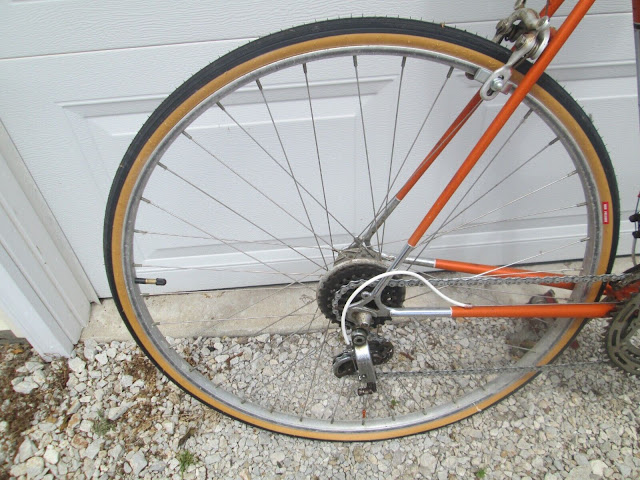It was what Sheldon Brown called "the Dark Ages of American Cycling." Or it was the "dark before the dawn" of the North American Bike Boom that began, depending on whom you ask, around 1969.
I am talking about 1962: 60 years ago. At the end of Bob Seger’s "Night Moves," the reminiscing narrator is "humming a song" from that year: the Ronette's "Be My Baby,” according to Seger.
That year, Algeria won its independence--at least, in name--from France as Jamaica did from England. A certain English band was playing at the Star-Club in Hamburg, West (yes, it was West) Germany. And--what I am about to reveal might cause some of you to never read this blog again--my favorite baseball team, the New York Mets, made their lovably, comically inept debut. (Their manager, Casey Stengel, lamented, "Can't anybody here play this game?")
And, although there were custom builders who made frames for the small but enthusiastic cycling communities of New York, Boston, Detroit, Chicago and a few other American locales, the name most Americans associated with quality bicycles was Schwinn.
Their company's top model, the Paramount, was built by hand in a separate area from the other bikes. I have heard, from more than one source, that Schwinn actually lost money on Paramounts. That sounds plausible: Similar British, French and other European bikes with Reynolds tubing and Campagnolo components cost less (1962 Paramount price: $175.00), mainly because the labor was less expensive. Supposedly, Schwinn continued to build Paramounts because they were the official bike of the U.S. Olympic team and Arnold Schwinn saw equipping the riders who represented his country as an act of patriotism. It also helped to support Schwinn's reputation as the only American bike-maker of that time with even a pretense of quality.
In 1962, Schwinn's second-line bike was the Superior. Its frame was similar to the model of the same name Schwinn introduced in 1976: chrome-molybdenum tubing filet-brazed without lugs into smooth joints and forged rear dropouts. Both bikes also had Weinmann centerpull brakes (the cool engraved version on the 1962 bike) and rims with Schwinn-approved large-flange hubs made in France, probably by Normandy.
Oh, and I love the stem and handlebars--made for Schwinn by Gerry Burgess (GB) of England. I can't get over that "lugged" sleeve on the handlebar:
Beyond those features, though, the 1960s and 1970s versions were very different. While both had Huret rear dropouts, the older version was equipped with the Huret Allvit derailleur: standard touring gear of that time.
The later Superiors came with Schwinn-branded Shimano or SunTour rear derailleurs--with, interestingly, Huret front derailleurs and shifters. While the Shimano and SunTour mechanisms shifted much better in almost any condition, they seemed to have an almost unfair advantage on the 1970s bike, a ten-speed with the Nervar crankset that used the Specialites TA Pro Vis 5/Stronglight 49D bolt pattern and a wide-range rear freewheel. On the other hand, the Allvit had to wrap up the yards and yards (OK, that's just a slight exaggeration) of chain necessitated by this:
The 1962 Superior certainly had 15 speeds--exotic for that time. To achieve it, Schwinn used something I've seen maybe a couple of times in all of my years of cycling and working in bike shops: a triple (with three chainrings) Ashtabula (one-piece) crankset. Made from solid forged steel, it probably weighed as much as the frame!
To be fair, there weren't as many cotterless cranks, or triples, available as there are now. Schwinn used three-piece cottered cranks only on their early Paramounts. Even the heaviest cottered cranks were lighter than any Ashtabula cranks, and some companies like Chater Lea, Stronglight and Duprat made cranks with pencil-thin arms. But, once Stronglight and Campagnolo came out with durable alloy cotterless cranksets, cottered cranks disappeared from high-end road bikes (though they would continue to be used on the track until around 1960).
Still, even in light of what I've just mentioned, that Ashtabula crank seems so incongruous with the rest of the bike. But, for most Americans in 1962, the Superior would have seemed as other-worldly as a spaceship.
By the way: the Superior cost $132 in 1962. That model was made for only another year and, interestingly, the price dropped to $126.50. From 1964 until 1970, the Super Sport--basically, a ten-speed version of the Superior--was Schwinn's #2 bike behind the Paramount. In 1971, the Sports Tourer would knock the Super Sport to #3 and become the new Superior in 1976.
.jpg)
.jpg)
.jpg)
.jpg)

.jpg)